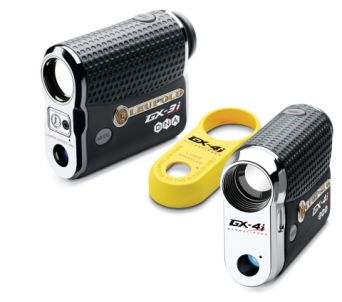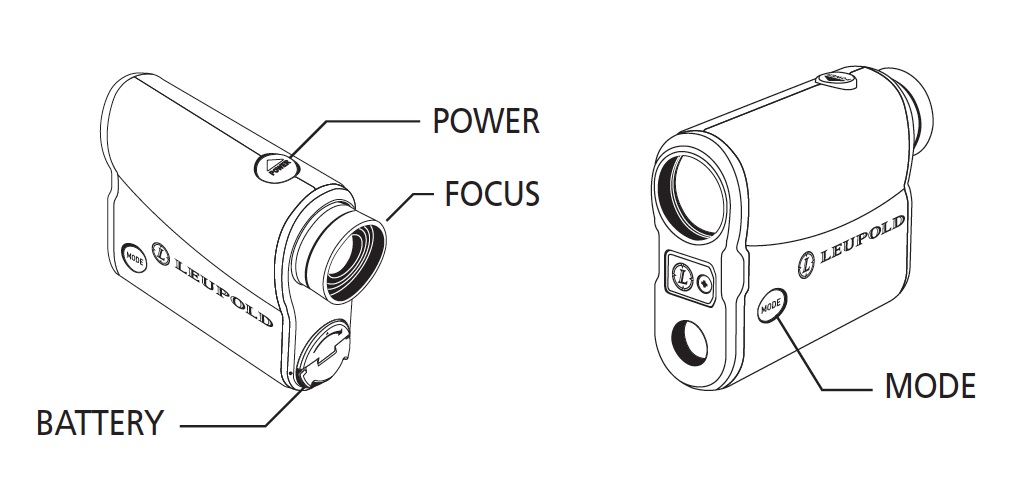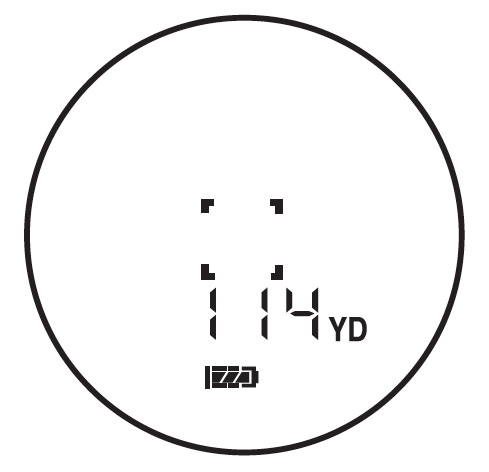The Leupold GX-3i is the next progression in the family of laser rangefinders from Leupold. Like the Leupold GX-3, the GX-3i features a rugged aluminum body and form factor that we love, a red OLED display that makes distances easy to read against any background, pin-targeting, prism lock, and the ability to scan across targets while receiving updated distance readings.
The Leupold GX-3i provides 6x magnification and a crisp display (albeit with a slight green tint), and only weighs 7.7 ounces. Enhancements to the device include an improved laser for accuracy within 6 inches and faster distance readings.
Even though distances are now displayed down to 1/10 of a yard, we found it both slightly more difficult to lock on to flagsticks, and the blinking of the bright OLED display while panning across multiple targets was a more distracting interface than the previous Leupold GX-3 (though relatively less so than the Leupold GX-4i, which also blinks additional information provided on slope-adjusted distance and angle in the display).
Pros:
- Good looks
- Red OLED display makes yardages easily readable
- Accuracy to within 6 inches, if Leupold’s press release is to be believed
Cons:
- High price tag
- More sensitive to targeting objects such as flagsticks and trees
- Distracting blinking distance readings
Retail: $499.99
Availability: Discontinued. Replaced by the Leupold GX-3i2
Amazon.com: Check price now
Golfsmith: Check price now
Those interested in the Leupold GX-3i but are looking to add slope-adjusted distances and club selection assistance will want to check out the Leupold GX-4i, which provides all the features of the Leupold GX-3i and more.
EASE OF USE
We have appreciated the form factor and good looks of Leupold laser rangefinders since their initial release, and this holds for the Leupold GX-3i. The GX-3i is a hair smaller than its brother, the Leupold GX-4i, and while both are two of the heavier vertically-held rangefinders in our tests, the difference between all of the devices is little more than an ounce. The vertically-oriented device is easy to hold – the aluminum body has a rubber exterior that provides a solid grip. The included carry case has a slot through which a belt or strap can be threaded, but we still miss the simple clip to attach the device to our bag. A magnetic latch keeps the case closed but the GX-3i easily accessible.
The 6x magnification of the Leupold family is the average magnification provided by golf laser rangefinders (the Bushnell Hybrid is at 5x, and the Bushnell Pro 1M line and Leica Pinmaster 2 are at 7x). The user focuses the display by twisting the eyepiece, though the Leupold GX-3i is slightly more difficult to focus with a single hand than competing devices.
The Leupold features two buttons – one located on the top of the device that powers the device on/off and fires the laser, and the other on the left side of the device that allows the user to modify settings. To modify settings, the mode button is initially held for one second, then is pressed repeatedly to cycle between different functions. The power/laser button is then used to toggle between settings for a specific function. The Leupold GX-3i allows the user to select either yards or meters as the standard unit of distance and to turn on and off fog mode (which toggles the distance algorithm to select the first/last targets).
The red OLED display is easy to read against dark or shadowy backgrounds and bright targets alike – distances appear below the crosshair along with battery life remaining. The viewfinder has a slight greenish tint, which is noticeable but not distracting, though we do prefer rangefinders without any tint to the display (such as those on the Bushnell Pro 1M and Leica Pinmaster 2 rangefinders).
The Leupold GX-3i’s “panning” mode enables the user to scan the course to obtain distances to different points while holding down the power/laser button. The device rapidly updates distance readings when panning across new targets. The speed that the distances are updated will vary slightly depending on target, but are extremely rapid in any situation. We found the blinking distances while panning more distracting than the steady display found in previous Leupold devices, slightly exacerbated by the fact that the distances are shown to an additional digit (0.1 of a yard). As mentioned, this is less distracting on the GX-3i than on the Leupold GX-4i, as the GX-3i doesn’t include slope-adjusted distance and angle information. We’ll let you decide whether your game is at a level where you benefit from seeing distances down to 0.1 of a yard.
The Leupold GX-3i takes one CR-2 Lithium battery. A battery meter is positioned in the lower center of the viewfinder.
For more details, check out the Critical Golf comparison of laser rangefinder ease of use.
FEATURES
The Leupold GX-3i has a pin-locating feature, which Leupold calls “PinHunter”, that makes it easier to determine the distance to specific targets such as flagsticks by filtering out readings from larger more “reflective” objects (like trees) in the background. It’s a great feature to have, but we found that the Leupold GX-3i has slightly less room for error before the device starts picking up objects in the background, often providing background distances when the target tree trunk or pin is still within a portion of the target cursor. The advantage to this is that it is easier to purposely target background objects when you have little room around tree trunks or branches (true, we aren’t always in the center of the fairway…it happens), but overall we would prefer that “PinHunter” give a bit more precedence to targets in the foreground.
Leupold uses its pin-locating mode all of the time, including while the user is panning across multiple objects, instead of requiring the user to switch back and forth between a panning mode and a “pin-locating” mode. The GX-3i also includes a “Fog Mode” that can be turned on and off to improve performance in fog and rain to screen out false readings, essentially turning off the “PinHunter” mode.
To make obtaining distances to flagsticks with reflective prisms even easier, the GX-3i features “Prism Lock,” a feature that is always enabled when scanning at distances over 30 yards. When the Leupold identifies a flagstick equipped with a reflective prism, it will emit an audible beep (you can turn this off), show brackets around the cursor and then freeze the display at the measured distance. It makes locking on to flagsticks with prisms at a distance so easy you’ll wonder why more manufacturers don’t have this functionality, and why more courses don’t have flagsticks with prisms.
Players can select from three different crosshair/aiming reticle options (see image to the right).
For more details, check out the Critical Golf comparison of laser rangefinder features.
OBTAINING DISTANCE READINGS
Leupold’s marketing materials state that the GX-3i is rated to provide distances to flagsticks and reflective targets at up to 450/800 yards under optimal conditions. Distance readings will continue to be displayed on the OLED for approximately 8 seconds after the firing button is released. The Leupold GX-3i allows users to continuously fire the laser for over 2 minutes, long enough to scan across all the targets you like.
Ease of Locking on a Target:
- At distances up to 175 yards, the Leupold GX-3i, like most of the competition, easily picked out flagsticks.
- At more than 200 yards well up to 300 yards, the Leupold GX-3i continued to perform well in picking up flagsticks against a dark background (90%+ of the time). In the high 200s the Leupold begins to have slightly more difficulty (though still picking out the flagstick at over 70% of the time), and at the very longest distances to pins without prisms it has slightly less success than the Bushnell 1600 Slope Edition, perhaps due to slightly lower magnification.
While we do not test to reflective targets/prisms, on-course experience revealed that the GX-3i easily and quickly locks onto prisms (see Prism Lock detail, above) at distances well in excess of 300 yards – a fabulous feature to have available.
Speed Test:
The Leupold GX-3i updates distance readings extremely rapidly. The device doesn’t update distances at a fixed speed, but rather updates will vary slightly depending on target. While it updates rapidly, it didn’t necessarily have the fastest times due to taking slightly longer with flagsticks to be comfortable that it was an accurate reading during our tests.
- Panning Mode: When we compared the Leupold in its one mode (since it always has panning and pin-locating available) against other devices in their “panning” modes, we found it to be about average among devices tested.
- Pin-Locating Mode: When we compared the Leupold in its one mode against other devices that have “pin-locating” modes, it was the faster devices – this is due to the benefit of the faster panning mode that it is quicker to scan across multiple targets.
- Using Both Modes: The Leupold also finished as one of the faster devices tested when using both panning and pin-locating modes together (which, in the case of other devices, required pushing buttons to cycle between modes).
For more details, check out the Critical Golf comparison for ease of obtaining distance readings.
COST/VALUE
At $500 retail, the Leupold GX-3i falls at the high end of our cost comparison of laser rangefinders that are USGA-compliant (i.e. ones that don’t show slope information). It has less magnification than other devices with high price tags (the Leica Pinmaster 2 and Bushnell Pro 1M), but its price isn’t unreasonable for what it provides – a nice OLED display in a solid form factor.
Those who are looking for slope-adjusted distances and club recommendations may want to consider the Leupold GX-4i, which retails for nearly $200 above the Leupold GX-3i.






does it worth the extra money to choose the GX-3i over the GX-1i?
Thank you
A difficult decision, but we really are fans of the OLED display of the GX-3i vs the LCD of the GX-1i. So if you have the dollars, it certainly is worth serious consideration. The weight of the GX-3i is a bit more (though <2oz). The aluminum body of the GX-3i is pretty sharp too.
how do the calculation of the slope work?
Has anyone had any problems with their gx-3i mine just working got a new battery and still nothing! Any suggestions!